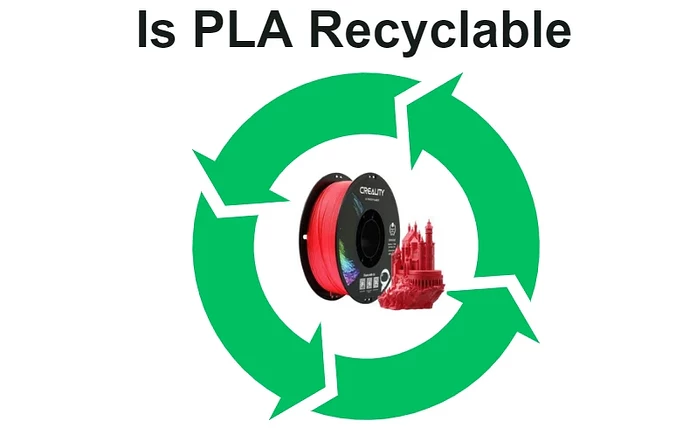PLA is a biodegradable plastic derived from renewable resources such as corn starch or sugarcane. With growing environmental concerns and the need to reduce plastic waste, PLA has emerged as a popular alternative to traditional petroleum-based plastics. Understanding the recyclability of PLA is crucial for fully realizing its environmental benefits.
We will talk about whether PLA is recyclable, the methods available for recycling it, and the challenges faced in the recycling process, providing a comprehensive overview of how to responsibly dispose of and recycle PLA products.
Is PLA Recyclable?
In theory, PLA is recyclable. However, unlike traditional plastics that can be recycled through standard methods, PLA requires specific conditions (include high temperatures, ample water, and ideally, digestive enzymes.) found in industrial composting facilities due to its biodegradable nature. Such specialized facilities are necessary to effectively break down PLA, limiting the popularity of PLA recycling options. Currently, the infrastructure for PLA recycling is not as widespread as standard recycling plants, often leading to PLA being landfilled or incinerated, thus contributing to plastic pollution.
Related Read: The latest PLA Report Supplement from PPC (Plastic Pollution Coalition) in Feb.2024
Filamentive’s New PLA Recycling Scheme
Can You Recycle PLA?
Recycling PLA involves various methods, including industrial composting, mechanical recycling, and chemical recycling, each with its own advantages and challenges.
Industrial composting is the most common method for recycling PLA, breaking it down into carbon dioxide, water, and organic matter under controlled conditions. This process requires specific temperatures and microbial activity, typically found only in industrial composting facilities, making it less accessible to everyday consumers. Home composting is generally ineffective for PLA because it lacks the necessary conditions to fully break down the material.
Mechanical recycling involves physically processing PLA waste into new products through sorting, cleaning, and remelting. However, this method is complicated by contamination from other plastics and the need for specialized equipment. The lack of widespread facilities capable of processing PLA further limits the efficiency of this method. Chemical recycling, while less common, offers a promising alternative by breaking down PLA into its monomers, which can be purified and repolymerized into new PLA. This method can handle contaminated or mixed plastic waste but is currently limited by high costs and technical challenges.
The availability of PLA recycling facilities is a significant obstacle. While industrial composting facilities exist, they are not as widespread as traditional recycling centers. Mechanical and chemical recycling facilities capable of processing PLA are even rarer. This limited infrastructure means that many consumers do not have access to appropriate recycling options for PLA. Consequently, a significant amount of PLA ends up in landfills, where it does not decompose as efficiently as in industrial composting environments. Additionally, the lack of consumer awareness about proper PLA disposal and the scarcity of recycling programs contribute to the challenges in effectively recycling PLA. Overcoming these obstacles requires increased investment in recycling infrastructure and greater public education on the importance of proper PLA disposal.
How to Recycle PLA
For consumers looking to recycle PLA, there are several steps they can take to ensure proper disposal:
- Cleaning and preparing PLA items: Rinse and clean PLA products to remove any food residue or contaminants.
- Finding local recycling options: Research and locate nearby industrial composting facilities or drop-off locations that accept PLA.
- Checking for community programs: Some communities offer specific PLA recycling programs or events.
- Exploring mail-in programs: Certain companies offer mail-in recycling programs for PLA products.
When local recycling options are not available, consumers can consider alternatives to reduce PLA waste:
- Reuse PLA items: Repurpose PLA products where possible to extend their life.
- Choose eco-friendly PLA alternatives: Opt for products made from materials that are more easily recyclable or compostable at home.
- Advocate for better recycling infrastructure: Support initiatives and policies that aim to expand PLA recycling facilities and programs in your area.
The Challenges to Recycle PLA
- Collection and sorting issues
- Contamination concerns
- Lack of infrastructure
- Economic factors
- Consumer awareness and participation
Conclusion
Recycling PLA is not without its challenges, but with continued focus and innovation, it can become a viable component of our efforts to reduce plastic waste. As an evangelist in the 3D printing industry, Creality is committed to enhancing 3D printing technology while promoting environmental protection. As consumers, we can contribute by paying attention to the use and disposal of plastics.
By understanding the complexity of recycling PLA, we strive to find solutions that meet our environmental goals and move towards a more sustainable future.
